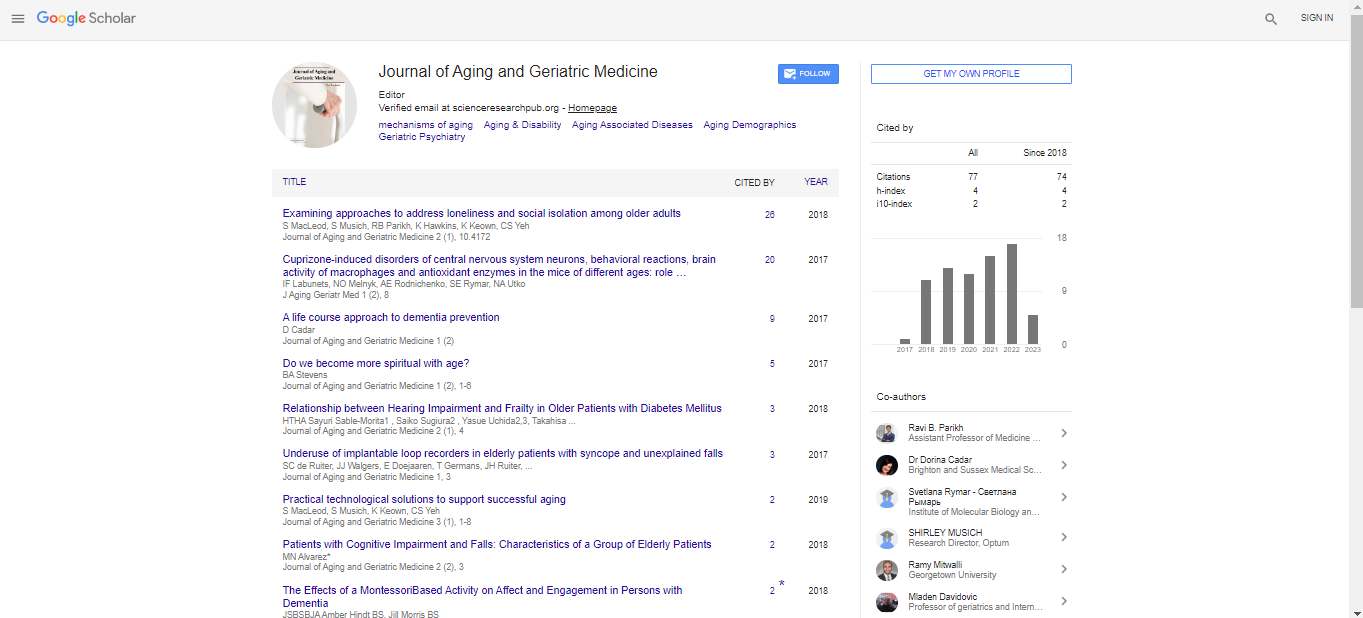Commentary, J Aging Geriatr Med Vol: 5 Issue: 12
Preferential Degradation of Cognitive Networks Differentiates Alzheimer’s Disease
*,
Department of Neurology, Massachusetts General Hospital, Harvard Medical School, Boston, MA 02114, USA
Corresponding Author:
Reisa A Sperling
Department of Neurology, Massachusetts General Hospital, Harvard Medical School, Boston, MA 02114, USA
E-mail: reisa@rics.bwh.harvard.edu
Keywords: Aging, Aging Science, Cognitive Impairment. Geriatric Psychiatry, Gerontology
Description
Converging proof from structural, metabolic and practical connectivity MRI indicates that neurodegenerative diseases, together with Alzheimer�??s ailment, goal unique neural networks. However, age-associated community adjustments generally co-arise with neuropathological cascades, restricting efforts to disentangle ailment-unique changes in community feature from the ones related to everyday growing older. Here we elucidate the differential outcomes of growing older and Alzheimer�??s ailment pathology thru simultaneous analyses of practical connectivity MRI datasets: (i) Young contributors harbouring highly-penetrant mutations main to autosomal-dominant Alzheimer�??s ailment from the Dominantly Inherited Alzheimer�??s Network (DIAN), an Alzheimer�??s ailment cohort wherein age-associated comorbidities are minimum and chance of development alongside an Alzheimer�??s ailment trajectory is extraordinarily high; and (ii) Young and aged contributors from the Harvard Aging Brain Study, a cohort wherein imaging biomarkers of amyloid burden and neurodegeneration may be used to disambiguate growing older by myself from preclinical Alzheimer�??s ailment. Consonant with previous reports, we found the preferential degradation of cognitive (specifically the default and dorsal interest networks) over motor and sensory networks in early autosomal-dominant Alzheimer�??s ailment, and determined that this exclusive degradation sample turned into magnified in extra superior tiers of ailment. Importantly, a nascent shape of the sample found throughout the autosomal-dominant Alzheimer�??s ailment spectrum turned into additionally detectable in clinically everyday aged with clean biomarker proof of Alzheimer�??s ailment pathology (preclinical Alzheimer�??s ailment). At the extra granular degree of person connections among node pairs, we found that connections inside cognitive networks have been preferentially focused in Alzheimer�??s ailment (with among community connections fairly spared), and that connections among undoubtedly coupled nodes (correlations) have been preferentially degraded in comparison to connections among negatively coupled nodes (anti-correlations). In contrast, growing older withinside the absence of Alzheimer�??s ailment biomarkers turned into characterised with the aid of using a miles much less community-unique degradation throughout cognitive and sensory networks, of among- and inside-community connections, and of connections among undoubtedly and negatively coupled nodes. We cross on to illustrate that formalizing the differential styles of community degradation in growing older and Alzheimer�??s ailment may also have the sensible gain of yielding connectivity measurements that spotlight early Alzheimer�??s ailment-associated connectivity adjustments over the ones because of age-associated processes. Together, the contrasting styles of connectivity in Alzheimer�??s ailment and growing older upload to previous paintings arguing in opposition to Alzheimer�??s ailment as a shape of multiplied growing older, and advocate multi-community composite practical connectivity MRI metrics can be beneficial withinside the detection of early Alzheimer�??s ailment-unique changes co-happening with age-associated connectivity adjustments. More broadly, our findings are constant with a selected sample of community degradation related to the spreading of Alzheimer�??s ailment pathology inside focused neural networks.
In the existing report, we study the speculation that selective vulnerability of specific networks to Alzheimer�??s ailment-associated degradation have to generate a exclusive multi-community sample of connectivity alternate so as to be observable throughout a huge spectrum of impairment, and that a nascent shape of this Alzheimer�??s ailment degradation sample can be identified in asymptomatic people with clean symptoms and symptoms of Alzheimer�??s ailment pathology (i.e. preclinical Alzheimer�??s ailment). Further, we study whether or not this Alzheimer�??s ailment sample of connectivity alternate is awesome from the degradation sample visible with growing older withinside the absence of Alzheimer�??s ailment pathology, and whether or not those differential styles may be used to expand composite connectivity measurements which can be useful in disambiguating Alzheimer�??s ailment- and age-associated connectivity adjustments. To higher isolate adjustments visible alongside the Alzheimer�??s ailment trajectory from the ones visible with growing older, we made use of practical connectivity MRI records from fairly younger people harbouring mutations main to autosomal dominant Alzheimer�??s ailment (ADAD) taking part withinside the Dominantly-Inherited Alzheimer�??s Network (DIAN); ClinicalTrials.gov Identifier
 Spanish
Spanish  Chinese
Chinese  Russian
Russian  German
German  French
French  Japanese
Japanese  Portuguese
Portuguese  Hindi
Hindi 